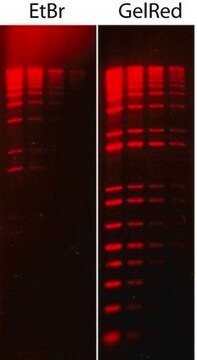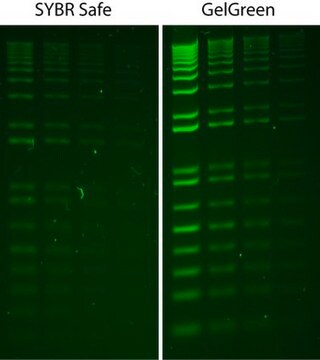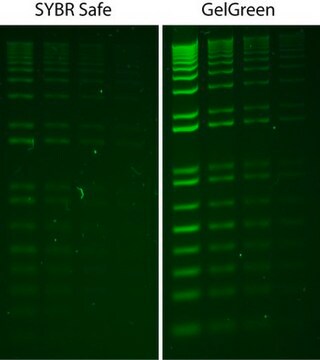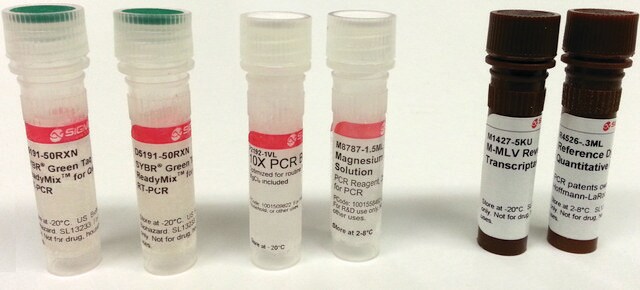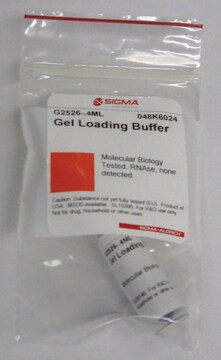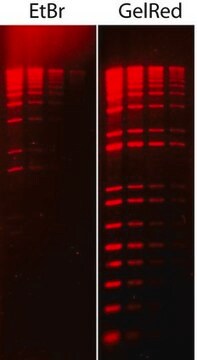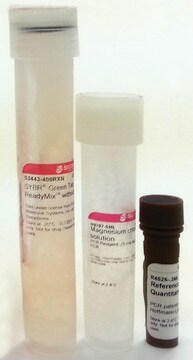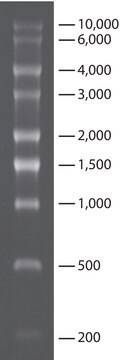Wszystkie zdjęcia(2)
Kluczowe dokumenty
S9305
SYBR® Green II RNA gel stain
10,000 × in DMSO
Synonim(y):
RNA gel dye, SYBR® RNA dye, safer gel stain
Zaloguj sięWyświetlanie cen organizacyjnych i kontraktowych
About This Item
Polecane produkty
zastosowanie
1 mL sufficient for 100 mini-gels
Poziom jakości
charakterystyka ekologicznej alternatywy
Designing Safer Chemicals
Learn more about the Principles of Green Chemistry.
sustainability
Greener Alternative Product
stężenie
10,000 × in DMSO
kategoria ekologicznej alternatywy
temp. przechowywania
−20°C
Szukasz podobnych produktów? Odwiedź Przewodnik dotyczący porównywania produktów
Opis ogólny
SYBR® Green II is a highly sensitive stain for post electrophoresis staining of RNA and ssDNA in agarose or polyacrylamide gels. SYBR® Green II is not selective for RNA staining but does exhibit a higher quantum yield when bound to RNA than to double stranded DNA.
Sigma Life Science is committed to bringing you Greener Alternative Products, which adhere to one or more of The 12 Principles of Greener Chemistry. This product has inherently safer chemistry, compared to the standard use of ethidium bromide for staining. For more information see publication found in related content.
Zastosowanie
SYBR® Green II RNA gel stain has been used:
- for the quantification of ribonucleic acid (RNA) in Escherichia coli
- for staining 5′-ETS rRNA species separated on polyacrylamide gel prior to Northern blot analysis
- to stain formaldehyde agarose gels to visualize RNA bands
Cechy i korzyści
- Ultrasensitive stain for post-electrophoresis staining of RNA and ssDNA
- Excited maximally at 497 nm with a secondary excitation peak at 254nm
- The fluorescence emission of SYBR®Green II stained RNA is centered at 520 nm
- Staining agarose/formaldehyde gels with SYBR Green II does not interfere with the transfer of RNA to membranes or subsequent hybridization in Northern blot analysis as long as 0.1% -0.3% SDS is included in prehybridization and hybridization buffers to remove the dye
- Might facilitate the detection of viroid RNAs and multicopy cellular RNA species
- More sensitive than ethidium bromide in applications that require extremely sensitive detection techniques such as single-strand conformation polymorphism (SSCP) analysis
Informacje prawne
SYBR is a registered trademark of Life Technologies
Ta strona może zawierać tekst przetłumaczony maszynowo.
zastąpiony przez
Numer produktu
Opis
Cennik
Klasa zagrożenia wodnego (WGK)
WGK 3
Środki ochrony indywidualnej
Eyeshields, Gloves, multi-purpose combination respirator cartridge (US)
Wybierz jedną z najnowszych wersji:
Masz już ten produkt?
Dokumenty związane z niedawno zakupionymi produktami zostały zamieszczone w Bibliotece dokumentów.
Klienci oglądali również te produkty
Human ??defensin-1 and -2 expression in the gingiva of patients with specific periodontal diseases
S. Vardar-Sengul
Journal of Periodontal Research (2007)
Benjamin Lau et al.
Molecular cell, 81(2), 293-303 (2020-12-17)
Ribosome assembly is catalyzed by numerous trans-acting factors and coupled with irreversible pre-rRNA processing, driving the pathway toward mature ribosomal subunits. One decisive step early in this progression is removal of the 5' external transcribed spacer (5'-ETS), an RNA extension
L G Lee et al.
Cytometry, 7(6), 508-517 (1986-11-01)
The purpose of this study was to find a 488-nm excitable fluorescent dye for reticulocyte analysis by the use of fluorescence activated cell cytometry. The chemical structure of thioflavin T, a dye used for reticulocyte analysis with 457-nm excitation, was
Dyes for in vitro detection of nucleic acids and proteins.
BioProbes, 20, 12-13 (1994)
Powiązane treści
Nancy-520 for DNA Detection and Quantitation
Nasz zespół naukowców ma doświadczenie we wszystkich obszarach badań, w tym w naukach przyrodniczych, materiałoznawstwie, syntezie chemicznej, chromatografii, analityce i wielu innych dziedzinach.
Skontaktuj się z zespołem ds. pomocy technicznej
